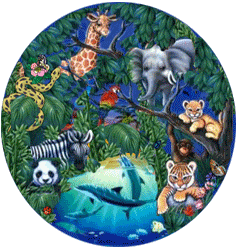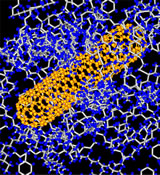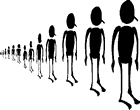|
The "web of life" is one of those phrases like "the be-all and end-all"—-it seems like you know what it means, but you might be hard-pressed to give someone a definition. But here goes anyway! ... along with some threats to this so-called web of life that supports us all.
Lions eat gazelle; gazelle feed on grasses; grasses get nourishment from the soil; soil is replenished and enriched by mycorhizal fungi, worms, bacteria and other organisms as they decompose dead vegetation and animal remains, including those of dead lions. So, in very short order we went from the king of the jungle to the extra-wee things in the dirt.
 In fact, the lowest species, such as fungi, bacteria, and phytoplankton, are among the most important but least-thought-of supporting members of the cast of millions in the long-running Web of Life Show. But all members and their interactivity are important to the proper functioning of the web.
In fact, the lowest species, such as fungi, bacteria, and phytoplankton, are among the most important but least-thought-of supporting members of the cast of millions in the long-running Web of Life Show. But all members and their interactivity are important to the proper functioning of the web.
There are many, many interconnected relationships in the wild, in farming systems, and even in our backyards. They crisscross and overlap in a tangled, complicated way, each playing specific roles. If a species is lost—i.e. goes extinct—other species may sometimes be able to jump into the gap in the ecosystem, but usually there will be a negative impact for other species that were dependent on the now-extinct species. Some species are such a critical part of their ecosystems that they're called keystone species, and their loss can dramatically alter the ecosystem.
We humans are the most advanced form of life. We have special characteristics and often consider ourselves separate from nature. But this is a false concept, if only in the sense that we cannot live without using other forms of life as food and to turn our exhaled carbon dioxide back into breathable oxygen.
The way the other members of the web of life support us humans is more complicated that that, but you get the idea. Like it or not, we need the web of life for our own survival, and it behooves us to treat it kindly.
Today, we know that species are going extinct at an unparalleled rate and that relationships between species are changing because of man-caused actions. How much disruption can the web of life take before a catastrophic shift takes place? Right now, that's still a scientific unknown, but it's easy enough to see that there will be some limit to the amount of degradation that can take place without catastrophic results for all life.
There are no doubt more than 10 threats to the web of life, but everyone seems to like Top 10 lists. So, if the FBI had a list of Top 10 Most Unwanted Threats to the Web of Life, it would go something like this.
HABITAT LOSS
 Habitat loss is the number one reason species are going extinct or are threatened. Habitat is lost to farming, logging, housing development and other building activities, and a number of other human activities.
Habitat loss is the number one reason species are going extinct or are threatened. Habitat is lost to farming, logging, housing development and other building activities, and a number of other human activities.
Solutions:
- Increase development density and better collocate housing and jobs.
- Foster economic solutions for rainforest peoples and countries that don't necessitate cutting down all the trees.
CLIMATE CHANGE
The climate has shifted in the past, and species have usually adapted. This time, however, man has placed a huge amount of infrastructure in the way of the gradual migratory shifts that would be essential to such adaptation. Climate change was recently identified as the number two likely cause of future species declines (after habitat loss).
Solutions:
- Reduce greenhouse gas emissions of:
- carbon dioxide (by reducing the use of fossil fuels);
- methane (by reducing feed-lot agriculture operations);
- other greenhouse gas chemicals (through industrial incentives and regulation).
INVASIVE SPECIES
Invasive species are plants or animals that have invaded a new area and are disrupting the native species in the local ecosystem. They profit from having few or no natural predators in their new area. Such species are not inherently evil, they just don't belong in their non-native habitats. It's usually humans that are responsible for introducing a species into a new area, intentionally via importation or unintentional via transportation of products.
Solutions:
- Strengthen inspections and regulations for imported plants and animals and other shipping activities that may unintentionally harbor hidden little buggers.
- Ban nurseries from selling plants that are non-native to their locales, and encourage gardeners to plant only native species.
CHEMICALS
Chemicals are everywhere these days—in the materials that make up the interiors of our cars and our computers; in the fabric of our clothes and furniture; in our household-cleaning and personal-care products. Every year, tens of billions of pounds of chemicals pollute our land, air, streams, lakes, groundwater, and oceans. The witch's brew of nastiness that permeates our global environment includes:
- PCBs, which are now banned but are so "persistent" that they are still everywhere and in everything, including us;
- dioxins, which are unwanted byproducts of industrial processes;
- phthalates, which are used in plastics;
- toxics such as lead, mercury, and cadmium;
- chemical pesticides (which are typically neurotoxins, by the way);
- PBDEs, which are widely used flame retardants.
Solutions:
- Recycle your electronics, rechargeable batteries, and other sources of toxics.
- Reduce the amount of plastic you use.
- Eat organic food. Insist on tougher regulations for pesticides.
- Stop using chemical pesticides on your lawn. There are alternatives!
- Tell your elected representatives you want the precautionary principle applied to chemicals—that is, chemicals should be considered toxic until it's proven they aren't.
NANOTECHNOLOGY
Nanotechnology is the new darling of the business and investment communities, based largely on their constant need to have a Next Big Thing.
 Beyond the hype, the ultra-small features of nanotechnology do have the potential to yield advances in many areas. But these nano-scopic particles also have the potential of running riot in the environment (and our bodies). The dangers are not being studied thoroughly, tests are not being conducted safely, and the results for all members of the web of life could be troublesome.
Beyond the hype, the ultra-small features of nanotechnology do have the potential to yield advances in many areas. But these nano-scopic particles also have the potential of running riot in the environment (and our bodies). The dangers are not being studied thoroughly, tests are not being conducted safely, and the results for all members of the web of life could be troublesome.
For instance, in a 2004 study by the National Institute of Environmental Health Sciences, largemouth bass swimming for only 48 hours in a tank with nanomaterial concentrations of 1 part per million or less were found to have 17 times more brain damage as fish in untainted tanks. Other systems in the fish were affected too, implying a system-wide inflammatory response to the nanoparticles.
Solutions:
- Don't buy into the hype and "cool science" frenzy over nanotech.
- Tell federal and state governments they should be using their resources (your tax dollars) to monitor nanotechnology and ensure its safety, not to fund industry and university studies in this highly commercial area.
NURTIENT POLLUTION
Excess nitrogen and phosphate levels in streams, rivers and estuarine coastal waters ultimately cause problems with water clarity (which affects aquatic plant life) and oxygen levels (which can cause low-oxygen coastal dead zones). Runoff from farming operations and improper sewage treatment are the two main causes of nutrient pollution.
Solutions:
- Buy organic food. (Organic farms don't use high-nutrient chemical fertilizers.)
- Check to see what your local governments are doing to crack down on poorly performing sewage treatment plants.
- If you feel the need to fertilize your lawn, rake in some compost or use a slow-release fertilizer.
ACID RAIN
Emissions of sulfur dioxide and nitrogen oxides are the two main causes of acid rain. The main sources of these emissions are the tailpipes of our vehicles, the stacks of coal-fired power plants, and other industrial operations.
Acid rain can kill trees and acidify lakes and other bodies of water to the extent that the life in them dies. Although some progress has been made in reducing the emissions that cause acid rain, we still have quite a ways to go.
Solutions:
- Conserve electricity. Put on shorts and keep the A/C higher. Put on a sweater and keep the heat lower. Invest in a high-efficiency heating and A/C system. Switch over to compact fluorescent bulbs. (All that saves you money in the long run, too!)
- Drive a high mileage, low-emissions car. See what cars have the best emissions profiles at Tailpipe Tally.
OVER-POPULATION
 Many of the threats to the web of life are threats only because there are so many people contributing to the problem. We must reverse population-growth trends in the US and globally; otherwise, progress on web-of-life threats could be swamped by the addition of more humans that will ultimately destroy habitat for housing and agriculture and by more people contributing their sewage, trash, chemicals, and other pollutants to the planet.
Many of the threats to the web of life are threats only because there are so many people contributing to the problem. We must reverse population-growth trends in the US and globally; otherwise, progress on web-of-life threats could be swamped by the addition of more humans that will ultimately destroy habitat for housing and agriculture and by more people contributing their sewage, trash, chemicals, and other pollutants to the planet.
Solutions:
- Support effective programs for birth control and family planning
- Tell the US government to once again support the United Nations Population Fund
GENETIC ENGINEERING
Genetic engineering has excellent potential to advance crop and animal science—within reason. However, it also has the potential to wreak havoc with the natural world. Right now, the state of the science is still crude and results are unpredictable, yet lax rules control experiments and field tests. This combination has the potential for big trouble.
Solutions:
- Protest the generally irresponsible pursuit of GE by buying organic food as well as food and beverage products labeled "No GMO."
- Tell USDA, FDA, and EPA you think their testing oversight is too lax. Remind them that their jobs are to regulate, not promote, GE products.
RADIATION
Everyone knows that high-frequency radiation causes disease and genetic mutation at certain levels and death at higher levels. That's true for humans, animals, and plants.
The earth's ozone layer helps protect us and all life from harmful ultraviolet light. If the ozone layer were to fail, we humans might be able to put on hats and sunglasses or spend more time indoors, but the rest of life would not. As the plants died off, so would the animals—and so would we. We must continue to make progress on efforts to rid the world of ozone-depleting substances.
Nuclear terrorism is a potentially serious source of radiation exposure, as are nuclear reactors and the continued stockpiling of radioactive waste from nuclear power plants.
Solutions:
- If you replace your home's A/C unit, be sure to purchase one that uses a non-ozone-depleting cooling substance.
- Tell the US government to stop requesting exemptions for the pesticide methyl bromide, a potent ozone depleter that the world (including the US) agreed to phase out by 2005.
- All world governments need to begin a crackdown on the black-market trade in illegal ozone-depleting CFCs.
- The world needs to begin a phase out of this dangerous technology, and the US should lead the way. Unfortunately, US leaders are currently pushing for even more nuclear power plants.
|


